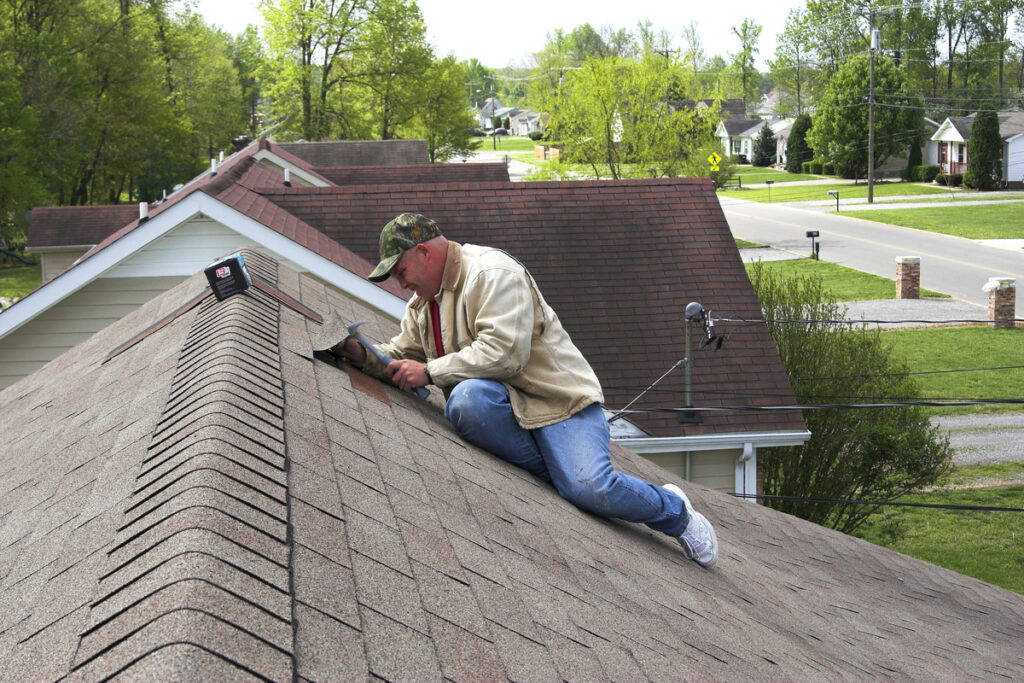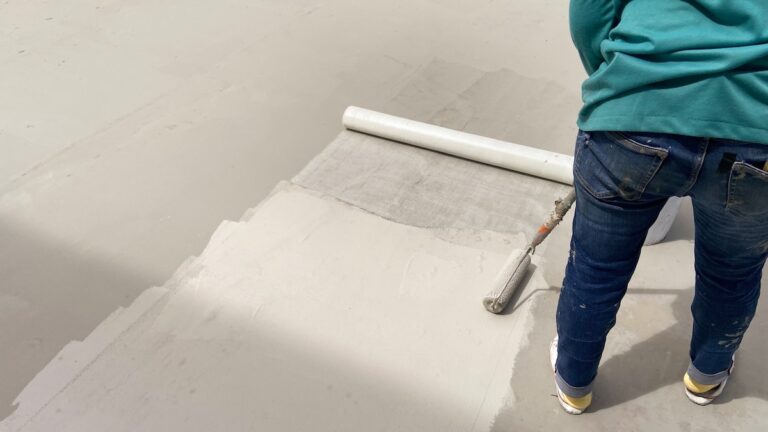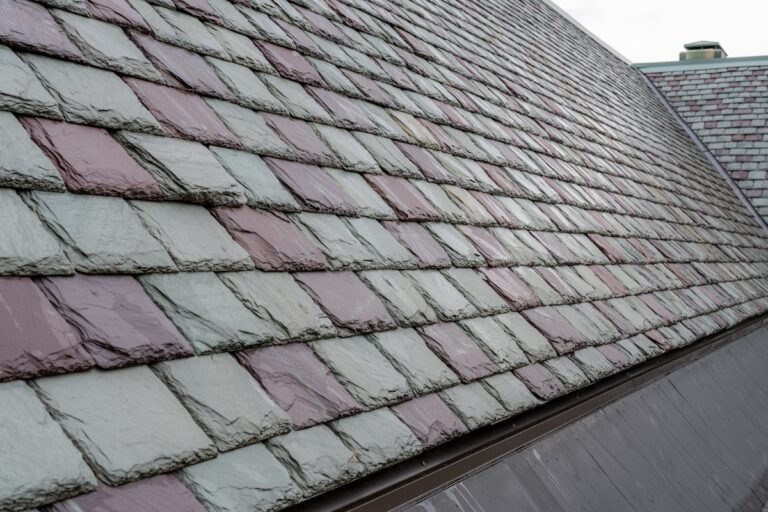Roof pitch isn’t just about angles and slopes—it’s a game-changer in roofing design and construction. It shapes the story of your roofing system in more ways than one, influencing its visual charm, durability, and overall performance.
Why does it matter? The pitch of your roof impacts:
- The look of your home – Whether you’re aiming for a dramatic, modern edge or a classic, cozy vibe, roof pitch plays a starring role in your home’s aesthetic.
- How your roof handles the elements – From shedding rain and snow to standing strong against high winds, the right pitch ensures your roof is more than just a pretty face; it’s built for resilience.
- Everyday function – A cleverly designed pitch isn’t just functional—it also enhances energy efficiency and makes maintenance easier.
We’ve crafted this guide to help you unpack everything you need to know about roof pitch. From understanding what it is, why it’s essential, and how it affects your roof’s performance, to calculating pitch easily and highlighting the importance of hiring professionals—this guide has you covered. Get ready to explore the ins and outs of creating a roof that works as great as it looks!
Key Takeaways
- What is Roof Pitch: Pitch defines the roof’s slope, expressed as a ratio (e.g., 4:12), showing vertical rise per horizontal foot.
- Impact on Performance: It directly controls water drainage and snow load capacity, preventing pooling.
- Material Suitability: The pitch dictates the appropriate roofing material; steeper slopes are needed for metal and tile.
- Aesthetic and Cost: Pitch affects home appearance and can influence costs—steeper roofs cost more but may offer better longevity.
- Calculation Methods: Pitch can be found using the Rise-Run Method, a Pitch Gauge, or an online calculator, though final verification should be left to pros.
What is Roof Pitch?
Roof pitch refers to the slope or steepness of a roof. It’s typically expressed as a ratio indicating the vertical rise (in inches) for every horizontal foot of the roof (in feet). For example, a roof with a pitch of 4:12 rises 4 inches vertically for every 12 inches horizontally.
Why Roof Pitch is Important to Know
Understanding your roof’s pitch is crucial for several reasons:
- Aesthetic Appeal: Different roof pitches can dramatically change the appearance of a home or building. A steep pitch might give a classic, imposing look, while a shallow pitch can provide a modern, streamlined appearance.
- Water Drainage: Pitch affects how effectively water drains off the roof, preventing pooling and leaks. Steeper pitches shed water more quickly and efficiently than flatter ones, reducing the risk of water damage.
- Material Suitability: Certain roofing materials are better suited to specific roof pitches. For example, slate and clay tiles are often used on steeper pitches, while asphalt shingles can be applied to a wider range of pitches.
- Snow Load: In regions with heavy snowfall, roof pitch is critical for shedding snow and preventing excessive weight buildup that could lead to structural damage or collapse.
- Ventilation and Attic Space: Steeper pitches may offer more attic space and better ventilation options, which can be beneficial for the overall health and efficiency of the building.
How Your Roof Pitch Affects Your Roof
The pitch of your roof impacts various aspects of its performance:
- Roofing Materials: Some roofing materials require specific pitches for proper installation. For example, metal roofing typically requires a minimum pitch to ensure water tightness and longevity.
- Maintenance Needs: Shallower pitches may accumulate debris more easily, requiring more frequent cleaning to maintain optimal performance and prolong the roof’s lifespan.
- Insulation and Energy Efficiency: Roof pitch can affect how insulation is installed and the energy efficiency of the building. Steeper pitches may provide more room for adequate insulation and airflow, contributing to better energy performance.
- Longevity: Proper pitch contributes to the longevity of roofing materials by ensuring effective water drainage and reducing the risk of water damage that can compromise the roof’s integrity over time.
3 Methods to Calculate Roof Pitch

Determining your roof pitch is a key step in understanding how your roof performs and interacts with the rest of your home. Here’s a more detailed look into the different methods you can use to calculate roof pitch accurately:
The Rise-Run Method
This classic approach involves measuring the vertical rise (height) and horizontal run (depth) of the roof slope. Start by using a level and a tape measure. Place one end of the level against the roof surface and make sure it’s perfectly horizontal. Measure 12 inches along the level (this represents the run) and then use your tape measure to find the height (rise) from the roof surface to the bottom of the level at that point. The pitch ratio is calculated by dividing the rise by the run. For example, if your rise is 6 inches and the run is 12 inches, your roof pitch is 6:12. This method is straightforward and gives a clear representation of the slope’s steepness.
Using a Pitch Gauge
A pitch gauge is a specialized tool designed to simplify roof pitch measurements. These tools, often equipped with bubble levels and angle readings, can be placed directly on the roof slope for an immediate and accurate pitch measurement. Digital versions can even give you an exact angle in degrees or convert it into a pitch ratio automatically. A pitch gauge is especially useful for roofing professionals or homeowners wanting quick and precise results without manual calculations.
Online Calculators
If manual measurements aren’t your style, there are numerous online calculators that can streamline the process. To use these tools, you simply input the measurements of rise and run, as described in the Rise-Run Method, and the calculator will instantly provide the pitch ratio. Advanced versions may also convert this into angle degrees or even provide additional insights like roof area coverage based on input dimensions. These calculators are user-friendly, accessible, and excellent for ensuring accuracy without additional tools.
By using one or more of these methods, whether you’re doing a DIY project or preparing for professional help, you’ll gain a better understanding of your roof’s pitch and its implications for design and performance.
Why You Should Leave Roof Pitch Calculations to a Professional

While calculating roof pitch might seem straightforward, several reasons make it wise to involve a professional:
- Safety Concerns: Climbing roofs to measure pitch can be hazardous without proper safety equipment and training. Professionals have the necessary training and equipment to work safely at heights.
- Accuracy: Roof pitch measurement requires precision to ensure accurate results. Professionals have the expertise to accurately measure and interpret roof pitch, taking into account factors like roof structure and design.
- Material Selection: Professionals can recommend roofing materials suitable for your specific roof pitch and local climate, ensuring optimal performance and longevity of the roof system.
- Compliance: Ensuring compliance with building codes and manufacturer specifications is crucial for the structural integrity and warranty validity of the roof. Professionals understand these requirements and can ensure that your roof meets all necessary standards.
Other Details to Keep In Mind
When it comes to dealing with your roof pitch, you can’t be too prepared! Here are a few things to keep in mind:
Common Roof Pitches:
Common roof pitches range from 4:12 to 12:12, with variations depending on architectural style and regional climate factors. Each pitch has its advantages and suitability for different roofing materials and design preferences.
Roof Design Options:
The pitch of your roof can significantly impact the overall design and style of your home or building. Architects often consider roof pitch as part of the building’s aesthetic and functional design.
Roof Pitch and Cost:
Roof pitch can influence installation costs and long-term maintenance expenses. Steeper pitches may require more labor and materials, impacting initial installation costs but potentially offering savings in maintenance and energy efficiency over time.
Consequences of Pitch in Climate
The angle of your roof directly impacts how it handles local weather, which is the single most important factor for its longevity.
Snow Load and Weight
In areas with heavy snowfall, a steep roof pitch is non-negotiable. Steeper roofs allow snow to slide off before its weight can build up. If the pitch is too low, the snow accumulates, putting tremendous, sustained stress on the structural framing and increasing the risk of collapse.
Water Drainage and Leaks
A steeper roof pitch ensures water drains rapidly into the gutters, preventing “ponding” (water pooling). On shallow roofs, water moves slowly, giving it time to find weaknesses, degrade sealants, and seep under the shingles, which is the number one cause of costly internal leaks.
Material Longevity
The right roof pitch protects the materials themselves. By shedding water quickly, a steep pitch reduces the time that moisture-retaining elements like moss and algae have to grow, helping your shingles or tiles last closer to their intended lifespan.
Use Us As Your Roof Pitch Calculator!
Roof pitch plays a pivotal role in the functionality, durability, and aesthetic appeal of your home or building’s roof. Whether you’re building a new home or replacing an existing roof, considering roof pitch as a fundamental aspect of your roofing strategy will lead to better long-term outcomes and satisfaction.
If you need to know your roof pitch, and also need a helping hand, Johnson Restoration is the team to call! Contact us today to learn about our comprehensive list of roofing services.






